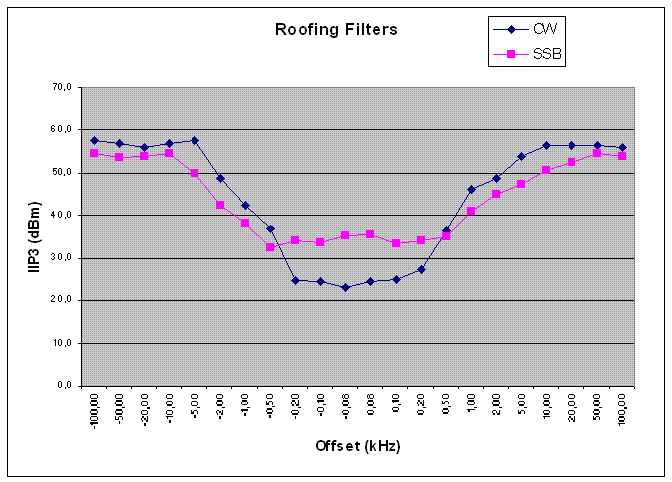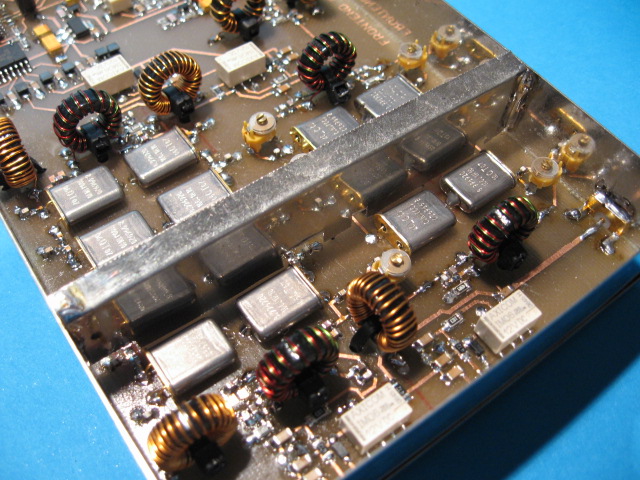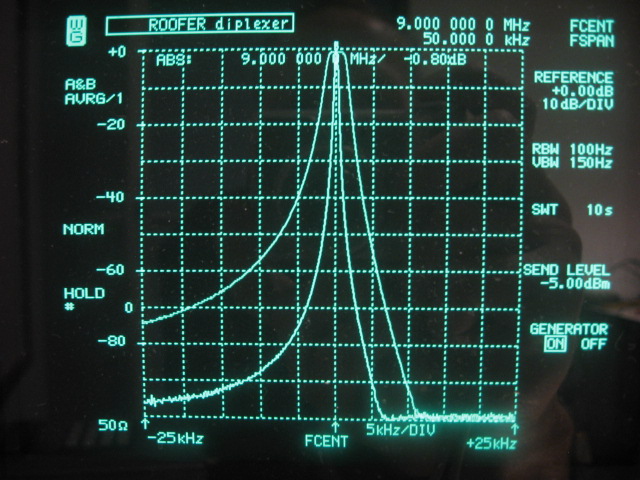Quadrature Hybrid Roofing Filter
Commercial crystal filters are often well specified regarding bandwidth, shape-factor, insertion-loss, ripple and stop-band attenuation, but no manufacturer that I have heard of guarantees the IMD properties of their crystal filters. Not even crude measurement data is given! In practice, the out of band IMD performance of the crystal filters that can be purchased off-the-shelf today rarely exceeds far beyond an IIP3 of +30dBm. Clearly there is a very big gap between the OIP3 of the H-Mode mixer, which on 40M can be as good as +47dBm(!), and the IIP3 of the crystal roofing filter that follows it. In fact, if the roofing filter has an IIP3 of around +30dBm, we only need an H-Mode mixer with an IIP3 of around +36dBm... This seems to be a natural boundary. A frontend with an IIP3 below +36dBm is not exceedingly difficult to achieve. Beyond +36dBm things are beginning to be tougher. Passive components like coils, transformers, crystals and even capacitors have a tendency to become slightly non-linear at those levels and everything, including the measurement system, begins to present difficulties.
In order to improve the IMD performance of the roofing filter and unleash the performance possible with the H-Mode mixer, the CDG2000 frontend features a homemade SSB roofing filter at 9MHz that is build from discrete crystals. Two 4-pole sections are combined with quadrature hybrids. The advantage with regard to IMD of this approach is twofold: The mixers IF port sees a much more wideband 50 ohms load and the individual 4-pole sections operate at a 3dB lower signal level. At the mixer side the filter is also terminated with a diplexer further ensuring a wideband 50 ohm termination. This is the original schematic of a single 4-pole ladder section as used in the 9MHz CDG2000 hybridized roofing filter:

Depending on the Q of the crystals a roofing filter can be constructed with an IL of better than -1.0dB. This makes it possible to build a frontend with a NF better than 10dB without a preamplifier anywhere before the roofing filter. This is the very successful concept of the CDG2000 frontend design.
Quartz and IMD
Building the roofing filter from discrete parts does not guarantee a very good intercept point by itself. It all comes down to the quality (=linearity) of the individual components. Especially the crystals! Because of the digital revolution, quartz crystals have become mass produced components (mainly China these days) and are therefore very cheap, which is good. But crystals that are manufactured to be used in crystal oscillators for digital circuits do rarely have the quality that is needed to construct a high-end crystal filter. Their Q is good enough to get an oscillator starting reliably and keep it going, but usually not good enough to produce filters with very low insertion loss. Even worse, the 'oscillator-grade' crystals also lack linearity. The surface finish plays a big role in the linearity of the quartz. Particles (micro dust) polluting the surface of the quartz are known to cause IMD. To make things considerably worse, the IMD they cause is not following 3rd order law by any means.
Once a source was found of very clean produced low loss crystals it proved possible to build roofing filters with low insertion loss (around -1dB) and very high intercept point, with reasonable shape factor at 9MHz. First a 2.6KHz SSB version of the filter was build and next a 500Hz wide CW filter. Both filters are described in more detail with measurements in the following pages.
For those worried that those crystals are not affordable: The 14 crystals needed to build a CW and an SSB roofing filter with, will approximately cost the same as a single KVG XF9B commercial crystal filter. Given the fact that these crystals remove the roofing filters from the IMD bottleneck in the frontend I think they are worth it!
Filter bandwidth and IMD
The CW and the SSB roofing filters have excellent out of band IP3 above +50dBm. The intercept is maintained very close-in, but degrades inside the pass-band. The SSB filter degrades to +35dBm and the CW filter degrades to +24dBm. This is almost a 12dB of intercept reduction while decreasing the bandwidth with a factor 4. There seems to be a 6dB per octave relationship between intercept and filter bandwidth!
Both filters are made with the same high quality quartz, high quality capacitors and hybrids. This gives, without having made extensive measurements on a large number of different crystal filters, firm ground for the 6dB per filter octave theory! Furthermore, Colin, G3SBI, has found rather similar behavior with 45MHz commercial crystal filters used in his Up-Conversion Frontend. But Colin also observed a further degraded close-in out of band IP3 with the narrow VHF crystal filters, which makes things considerably worse! Maybe this is caused by the rather different monolithic construction of those filters compared to their discrete cousins at 9MHz. At 9MHz with discrete parts, the CW roofing filter performed even better close-in than the SSB filter!
The following graph shows IIP3 at different offsets for both 9MHz roofing filters. The two filters maintain a very good out of band intercept point very close to the filter pass-band. The difference in in-band IMD is quite obvious!

The same effect is also noticeable with discrete LC BPF's, quite like the BPF's used in this frontend! The more selective the filter is, the higher the loaded Q and voltage will be and more non-linearity will occur. For this reason, and also to keep IL low, the loaded Q of those BPF's was kept below 10. The presented ladder quartz filters in this frontend are very similar in topology, to the Series-Trap, Shunt-C BPF's, when you look at the crystals equivalent RLC circuit. With the LC filters it is the magnetic flux causing distortion due to non-linearity of the iron-powder. With the quartz filters it is the mechanical resonance causing distortion due to surface impurities on the quartz.
The increased IMD that is generated inside narrow filters puts a question mark behind the correctness of the generally accepted opinion that a narrower (roofing) filter is always better. There is definitely a trade-off going on unless the roofing filter has about the same bandwidth as the desired signal, while maintaining sufficient in-band IP3. The presented roofing filters for this frontend have these properties.
At present time this cannot be achieved with the low-VHF roofing filters used in popular high-end up-conversion radios. Even the narrowest VHF roofing filter is much wider than the desired narrow bandwidth for CW. The ultimate CW selectivity is usually achieved with DSP, one or two IF's further down the line! The gain stages and mixers from the VHF-roofer up to the ADC, will be prone to contributing further to the cascading in-band IP3 figure, probably sometimes even more than the roofing filter itself.
When using a 500Hz roofing filter with an in-band IP3 of +24dBm the intercept point will not likely be a problem anymore. Chances of getting problems with IMD inside that pass-band are overshadowed much by reciprocal mixing caused by close-in phase noise of the local oscillator.
Realization
A close-up of the roofing filter section of the frontend board. To the left is the 2x 4-pole SSB filter, to the right is the 2x 3-pole CW filter. Note the shield to improve the stop-band beyond -100dB and the small trimmers needed to align the CW filter to center exactly on 9.000000MHz.

The toroids are positioned on small pieces of FR4 to create more distance to the board and are held firmly in place with 2.5mm tie-wraps.
The following 50KHz wide network analyzer plot shows the 2 roofing filters in "overlapping" action! Subsequent filtering will only have to polish-up the shape factor. Stop-band is covered by the roofers.

In practice
Helmut Dick, EA5GNI, is actively using both roofing filters in his homebrew rig. 'Hal' is a very experienced CW operator and has a really competitive antenna setup with full-size stacked beams for 40M, 30M, 20M and 17M and can test those roofing filters in real-life big signal conditions like no one else! I leave it to him to describe his recent experience with the 500Hz CW roofing filter:
|
In late January 2008 I had the opportunity to install the 500Hz CW roofing filter into my homebrew receiver. Martein was so kind to give it to me as a late xmas gift and he certainly made an old CW- rag- chewer happy!
|
|
My homebrew receiver contains all the building groups which were developed by Martein. As narrow filters I use KVG XF-9NB and XF-9P. The XF-9P is used nearly all the time. I do not have any other filters.
|
|
Prior to the receipt of the roofing filter Martein made his measurements also available to me and my expectations were pretty high! The filter was installed in minutes. It replaced the SSB roofing filter. By moving the SMA coax connectors I could "switch" between filters. I also could bypass the narrow KVG filters with the same method.
|
|
My first tests were made on 20M with pretty low activity. The only difference with the SSB roofer was a change of the background noise. I can describe it as less sharp or with less hiss. The change is not much but it can be noticed.
|
|
Switching to 40M with full activity was and still is a different world! I suddenly could read stations which were in the noise when I switched back to
the SSB roofer. It is absolutely true that CW is fun with a 500Hz roofing filter. Even the excellent SSB roofing filter can be topped! Strong signals with 30 or 40db over S-9 just disappear and do not affect the weak signal at all.
|
|
I also tried the CW roofing filter without the narrow KVG filter. In this configuration it easily can be heard that the 500Hz roofing filter is not
a narrow filter which it is not intended to be. Both filters are needed in a high performance receiver. Without the roofing filters the narrow filters soon are at their limits.
|
|
Unfortunately there are some CW signals with a poor CW note causing key clicks and "phaseswishhhh" noise which is now more noticeable and that cannot be "roofed" away. If I remember right our GELOSO- VFO some 50 years ago produced a far better CW signal than some of the "high-end transceivers" of nowadays. I might be wrong.
|
|
After many many DX QSO's with friends from all over the world I don't want to miss that roofing filter. It is a great improvement and certainly not only for an old fashioned guy like me.
|
SSB Roofing Filter
CW Roofing Filter
Back to Frondend Board
Back to the TOC
|